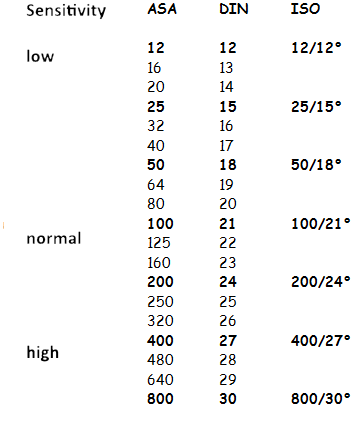





The objective
- The point of convergence is the point where the rays from an object point converge. The objective (lens) is constructed so that all points of convergence are (more or less) in a plane.

- If the film is exactly in this plan, so we focused properly.

- If the subject is too close, the plane of convergence points moves backward, for each point of the object the result is a stain on the film. It was not focused properly. Solution: Move the objective away from film!

- If the subject is too far away, the plane of convergence points moves forward, for each point of the object the result is still a stain on the film. It was not focused properly. Solution: Move the objective nearer to the film!
- → The focal length of a lens is the distance between lens and film when an infinitely distant object is focused properly. .

- Wide-angle lenses have small focal length (< 50 mm). They reduce the object and enlarge the image framing.

Normal lenses have a normal focal length (50 mm):

The great telephoto lenses have small focal lengths (> 50 mm): They magnify the object and reduce framing.
Aperture and depth of field

On the image plane only the rays issued from the red dot converge. However, blue and green dots have a blurred image.

If a diaphragm in the lens is used, the marginal rays are eliminated and the points of convergence migrate closer to each other. Thus is achieved a greater depth of field, namely the three colored dots are focused correctly in our case. But then it falls less light on the film, which must therefore be exposed longer!
Here are some aperture values often used with their traditional name: f/2.8; f/4; f/5.6; f/8; f/11; f/16 ..; f/22
Each of these values lets pass twice as much light as the next.

Exposure time
This is the time during which the diaphragm is open. You can often adjust it manually. The series of the exposure times is so constructed that from one to the other, the time during which the light is applied to the film is doubled or halved: The series of exposure time (in seconds): 1/2 1/4 1/8 1/15 1/30 1/60 1/125 1/500 1/1000 1/2000
The greater the exposure time, the smaller may be the aperture, the greater the depth of field. But then also the probability is greater than, for subject movement during this time, the image becomes blurry!
Film sensitivity
The more sensitive the film, the less time it has to be properly exposed to light.
The sensitivity is expressed in ASA (American Standards Association) or DIN (German Industrial Standard).
Higher numbers mean in both systems a greater sensitivity.
In the ASA series double value means a double sensitivity.
In the series DIN triple value means a double sensitivity.
There is also the internationally recognized ISO standard.
Fortunately ISO values are based on a combination of ASA and DIN!

The more sensitive a film is, the less light is needed to illuminate it and the smaller may be the aperture (Depth of field!) and also the lighting time (Movements of the camera!) However, sensitive films are often grainy, so they cannot be enlarged easily and often give less contrasting colors.
This text is an abridged version of the good Internet course (in German): → Striewisch-Photodesign